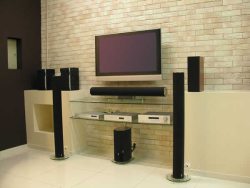There is nothing more relaxing than enjoying a good movie over the weekend. With the advent of home theater systems people prefer to watch their favorite movies within the comforts of their home.
The development of DVD player technology and Dolby digital surround sound systems has enabled movie aficionados to recreate the magic of watching movies in a theater in their own home. Installing a home theater system however is an activity which requires in-depth planning.
A theater in your home for your Home Theater
A Home Theater Installation is needed to enhance the experience of watching a movie with great sound effects and superior picture quality. The first thing to look out for is the location. A separate room to house your home theater system would be the best option. You could convert a spare room into your home theater or if not possible create space for the system in the living room itself.
Plan for best quality sound effects and image
The main aspect while installing a home theater system is the correct positioning of the flat screen TV and speakers. For a mid sized room, the TV screen can be installed on the wall facing away from windows. For best sound effects, prefer surround sound installation with the main speakers can be placed adjacent to the screen while the auxiliary speakers can be placed along the walls adjacent to the viewers.
The wires and cables can be concealed by running them through the walls or behind wall furnishing. Wireless surround sound speakers are quite popular as you can mount them anywhere in the room without having to bother about wires trailing along the walls or not being long enough.
Create the ambiance for your Home Theater
A point to be noted, the best home theater systems would look and sound mediocre if not installed in harmony with the surroundings. An overly lit room or one with a number of windows is not conducive for picture clarity. Lights that can be dimmed and windows with dark curtains would ensure that a theatre like ambiance is created.
Some aspects to be considered are
- • Sound effects
- • Audience location
- • Height, distance and angle of viewing
- • Design of the room
A home theater setup includes a flat screen TV, up to 8 speakers and other audio and video components that can take up a large amount of space. Wall units, mobile cabinets or racks are ideal to house the various components. Wall mounts look neat though would involve activities like drilling, taking measurements and concealing the cables in moldings or conduits.
Power arrangements for your Home Theater
The home theater system would need adequate power outlets with a dedicated power line to sustain the increased load. If it’s not possible to run a separate line from the circuit breaker a power strip and surge protectors would suffice to shield the system from power outages and fluctuations.
A separate socket with backup for components like the cable box and DVR would ensure that the system does not get switched off in case of a power outage. The feature is especially important if you like to record your favorite TV show or sports events. Also remember to mark each cable with the component name to which it is to be connected to avoid confusion.
Viewing distance for your Home Theater
The optimum viewing distance would depend on the size of the TV screen. For most flat screen TVs for home theater with a diagonal screen size of about 27 inches, the seating arrangement should be at a distance of 10 feet (about 3.1 meters) from the screen. You can select from a variety of Plasma, LCD or LED TV screens for your home theater. The image quality is similar for most flat screen TVs though the prices would vary according to the brand chosen and extra features availed.
Katie Browns writes for Nextday Techs, an on-site technical service firm offering expert technical solutions for home and office use. For more information about home theater installation services visit our website at http://www.nextdaytechs.com

